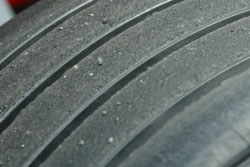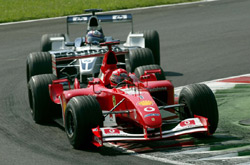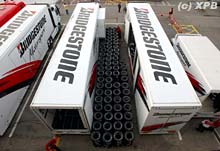
As Jaguar Racing's is fond of explaining: tyres are the only parameters capable of transmitting the power of the engine to the ground that they run on. Therefore perfecting tyre balance and grip is one of the most important aspects to a car's performance. An engine cannot find an extra three seconds per lap from one race to the next - tyres can.
Since Michelin returned to the F1™ racing track last year this issue has become even more complicated, as Bridgestone had operated alone in the sport since 1999. The extra pace of development forced by the competition between the two companies and varying designs provided by each manufacturer quickly introduced new parameters into GP preparation, and the media soon became fond of discussing the "tyre war" and its effects on the competition that already existed between teams.
Currently each car is allowed ten sets of tyres per GP weekend. However, each team has to make sure that three sets of the ten are returned at the end of Friday, thus leaving seven sets per car for Saturday's qualifying and Sunday's race.
Each manufacturer brings two different compounds (in some cases they will bring two different constructions but the same compound, although this is rare) to a race venue. Engineers from the respective teams then have the responsibility of deciding which particular compound is more suited to that track.
Most teams will use all three sets available for Friday free practice, and sometimes even dip into a fourth set, depending on how difficult tyre choice is proving at that track. By the end of free practice, they will have a rough idea as to which compound to choose for qualifying (and therefore the race, as the tyre type used in qualifying must then be utilised for the rest of the weekend).
Usually, the majority of teams prepare nine sets of each compound in advance on Thursday to save time on Friday and Saturday. Preparing tyres is time consuming because not only does each tyre have to be attached to the wheel one by one, but then the pressures have to be checked and the optimum temperature has to be reached in time for each session using special tyre warmers.
As long as the total number of used tyres does not exceed the allotted ten sets, teams can use all possible permutations available to them over the weekend.
For the rain tyres the rules are simpler. Seven sets per car are supplied for a weekend, and since each manufacturer is allowed to bring three different kinds of tyre, if teams wished they could prepare a maximum of 21 sets of tyres in total (no one does though). The combination they then put on the car is up to the team to decide.
There are two distinctively different tyres available to teams for coping with inclement weather - wet tyres and intermediate tyres. The former is for very wet conditions and the latter is for semi-wet conditions (the beginning of a rain storm or on a drying out track). Each has type has soft and hard compounds available and, moreover, there are several different radial patterns too.
These tyres, dry or wet, go through rigorous testing programmes to create the correct tyres for each circuit. The data from previous seasons often provides a good foundation as tyre companies approach the new round of Grands Prix, but this cannot be trusted 100% as track surfaces are affected by the weather and circuits are resurfaced or have modifications which affect their fundamental characterisitics, as we saw at Hockenheim in July.
Therefore, it is important that tyre manufacturers have the most up to date information for each track to hand when they decide which compounds to take away with them. Ideally the Grand Prix host track will hold a test session before the race, but not all circuits have testing licences so the teams and their tyre partners have to work at tracks with similar features and use computer simulations to ensure they have as much knowledge as possible.
When it comes to testing tyres, there are several factors to be considered. A
test can be divided into work focused on four different areas of the tyre,
catering for four different parameters - compound, construction, shape and size.

When teams talk about "compounds" they mean the hardness or softness of the rubber itself. For example, tyres used in Monaco are the softest compounds and would not last a lap of Silverstone, which is known to require one of the hardest compounds because of the number of fast corners included in the layout. A soft compound is "sticky" and therefore grips better, but is not as durable as its hard counterpart.
When the term "construction" is mentioned it refers to how the layers of the rubber are put together. Drivers' viewpoints differ very much on this aspect of tyre development, indeed it is very much like the set-up of the car and so depends on the driving style of each racer.
The stability of the car is greatly affected by constructional modifications to each tyres, and especially so at tracks like Imola, where drivers use the kerbs to get through the chicanes quickly, and upset the smooth style F1 cars prefer to run in.
The shape of a tyre decides the area where it makes contact with the ground. Narrower contact creates less drag on straights, but this means a sacrifice in cornering speeds. Some teams tend to put most emphasis on lateral traction, whereas others insist on front/back traction, and the shape of the tyre does have a substantial influence on this.
This also presents a challenge for the manufacturer, as they supply several teams which all have a different view as to the set-up which works best on their car and so the tyres needs to work well for all drivers.
Finally, the size refers to the width of a tyre, which affects the cars'
speed on the straights and through the corners. The current specification has
reached its maximum width, so tyres can only be made narrower and the benefit of
that depends on the balance (aerodynamic/mechanical) between the front and rear
of the car.

Tyres are now considered so important to the performance of a Grand Prix car that top teams are spending more time and effort than ever on this crucial aspect. Ferrari, for example, have a dedicated tyre testing team with Luciano Burti at the wheel, and rising star and second Williams test driver Antonio Pizzonia often carries out tyre testing for the Grove-based team.
In fact the rear end of last year's Ferrari F2002 was designed not to be as hard on the rear tyres as their car was last year. McLaren also realised in the early stages of their brand-new collaboration with Michelin this year that they were not making full use of their new tyres. Therefore, third driver Alex Wurz has been told to focus on modifications to the suspension in order to make the most of the French company's product.
They may still lag behind the mighty power of Williams, who had an extra year of partnership with Michelin last season, but at slower circuits like Monaco or Budapest their progress under race conditions has been clear to see.
Of all the circuits on the current FIA Formula One World Championship™ calendar, Silverstone and Barcelona are the hardest on tyres (because of the number of high-speed corners). There is a high degree of degradation and wear at the tracks to both manufacturers' products, and so the most durable compounds are used. At the other end of the spectrum there is Monaco, where super-soft tyres are taken (this time because of the slow nature of the track).
Other circuits are categorised somewhere between the two extremes. However, Monza and the old Hockenheimring, due to the sheer speeds reached down their straights, were often treated with care and Suzuka, with its combination of mid-high speed corners, creates a headache for tyre engineers every year to come up with the appropriate specification.
Surprisingly, Indianapolis, which has two completely opposite characteristics - one half (the oval) is extremely quick and the other (the infield) is very slow - does not pose problems of this magnitude. The fast section consists of one slightly curved straight (no tight corners requiring sudden braking and then sprinting off down another straight), and the rest is so slow as to not pose the problem of requiring high-speed cornering.
The extra competition introduced by the tyre war is relished by all fans and team members alike, but one aspect to it that has long been acknowledged by all concerned is - as long as the tyre war is on, F1 cars will continue to get faster. This presents the possibility that the FIA will impose further sanctions to reduce speeds and keep safety at its current high levels.
Although both manufacturers are keen to avoid this, they would most certainly take up the challenge and bounce back even faster than they had expected, as Bridgestone proved when grooved tyres were first made mandatory in the dry after years of super-grippy slick compounds!